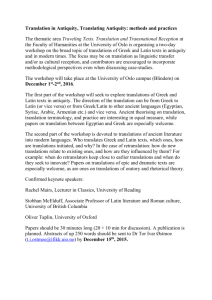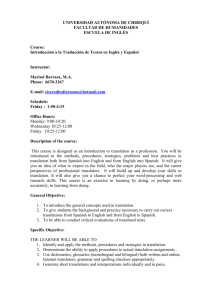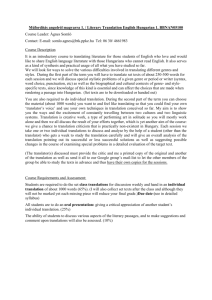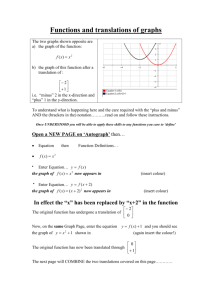Are translations longer than source texts
advertisement
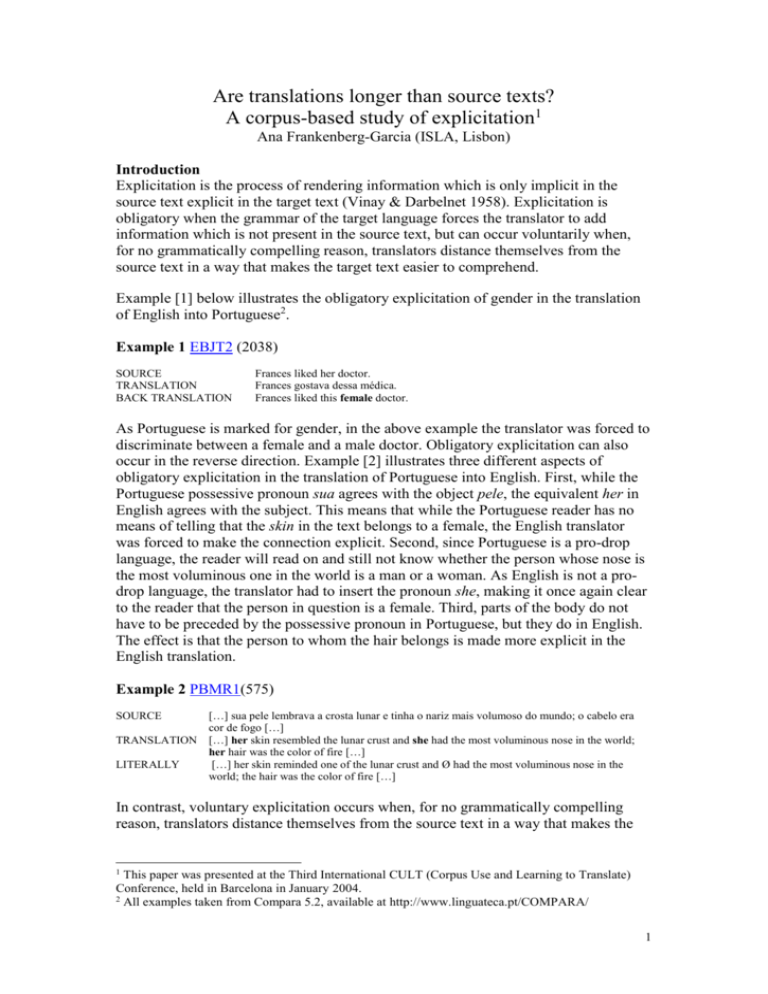
Are translations longer than source texts? A corpus-based study of explicitation1 Ana Frankenberg-Garcia (ISLA, Lisbon) Introduction Explicitation is the process of rendering information which is only implicit in the source text explicit in the target text (Vinay & Darbelnet 1958). Explicitation is obligatory when the grammar of the target language forces the translator to add information which is not present in the source text, but can occur voluntarily when, for no grammatically compelling reason, translators distance themselves from the source text in a way that makes the target text easier to comprehend. Example [1] below illustrates the obligatory explicitation of gender in the translation of English into Portuguese2. Example 1 EBJT2 (2038) SOURCE TRANSLATION BACK TRANSLATION Frances liked her doctor. Frances gostava dessa médica. Frances liked this female doctor. As Portuguese is marked for gender, in the above example the translator was forced to discriminate between a female and a male doctor. Obligatory explicitation can also occur in the reverse direction. Example [2] illustrates three different aspects of obligatory explicitation in the translation of Portuguese into English. First, while the Portuguese possessive pronoun sua agrees with the object pele, the equivalent her in English agrees with the subject. This means that while the Portuguese reader has no means of telling that the skin in the text belongs to a female, the English translator was forced to make the connection explicit. Second, since Portuguese is a pro-drop language, the reader will read on and still not know whether the person whose nose is the most voluminous one in the world is a man or a woman. As English is not a prodrop language, the translator had to insert the pronoun she, making it once again clear to the reader that the person in question is a female. Third, parts of the body do not have to be preceded by the possessive pronoun in Portuguese, but they do in English. The effect is that the person to whom the hair belongs is made more explicit in the English translation. Example 2 PBMR1(575) SOURCE TRANSLATION LITERALLY […] sua pele lembrava a crosta lunar e tinha o nariz mais volumoso do mundo; o cabelo era cor de fogo […] […] her skin resembled the lunar crust and she had the most voluminous nose in the world; her hair was the color of fire […] […] her skin reminded one of the lunar crust and Ø had the most voluminous nose in the world; the hair was the color of fire […] In contrast, voluntary explicitation occurs when, for no grammatically compelling reason, translators distance themselves from the source text in a way that makes the 1 This paper was presented at the Third International CULT (Corpus Use and Learning to Translate) Conference, held in Barcelona in January 2004. 2 All examples taken from Compara 5.2, available at http://www.linguateca.pt/COMPARA/ 1 target text easier to comprehend3. In example [3], the translator introduced the adverb so at the beginning of the English sentence, although it is neither present in the Portuguese source text, nor there is anything about the grammar of English that makes it compulsory. The effect is that the connection between the event described by that sentence and a previous one in the text is made more explicit in the translation. Example 3 PBAD1(435) SOURCE TRANSLATION LITERALLY Você também gosta dela? So you like her too? You like her too? As shown in example [4], exactly the same can occur in the translation of English into Portuguese. Example 4 EBDL3T2(799) SOURCE TRANSLATION BACK TRANSLATION "It's probably Rummidge. -- Então é provável que seja Rummidge. "So it's probably Rummidge. There is abundant evidence of voluntary explicitation in literature. Vanderauwera (1985), for instance, described numerous examples in the English translation of Dutch novels. Blum-Kulka (1986) found cohesive devices in Hebrew translations that were not present in English source texts. Séguinot (1988) found non-obligatory connectives in translations from English into French and from French into English. Based on studies such as these, voluntary explicitation has come to be viewed as one of the universals of translation (Vanderauwera 1985) and as something inherent to the nature of the translation process (Séguinot 1988). After a systematic study of the phenomenon from a perspective of discourse, Blum-Kulka (1986) put forward the explicitation hypothesis, which holds that translations tend to be more explicit than source texts, regardless of the increase in explicitness dictated by language-specific differences. In the beginning of the nineties, Baker (1993) predicted that qualitative studies such as the above could be greatly enhanced by quantitative, corpus-based analyses of translations. Indeed, Øverås (1998) examined explicitation and implicitation shifts in the English-Norwegian Parallel Corpus, and found that there was more explicitation than implicitation in both Norwegian translated from English and English translated from Norwegian. Using two comparable corpora, Olohan and Baker (2000) analysed the insertion of the optional that following the reporting verbs say and tell in data from the Translational English Corpus (TEC) and the British National Corpus (BNC), and found that the explicitation of that is more frequent in the English translations from the TEC than in the English originals from the BNC. The present study is an attempt to analyse voluntary explicitation from the perspective of text length. Because voluntary explicitation is generally achieved by the addition of extra words in the translation text, this study seeks to test whether translations are 3 Voluntary explicitation is being used here as an all embracing term that covers all explicitation that is not obligatory, from the explicitation of cultural information to the explicitation of syntactically optional elements. 2 likely to be longer than source texts, regardless of the languages concerned. Using the Compara Parallel Corpus of English and Portuguese4, the length of original English and Portuguese language fiction is compared with the length of their translations into Portuguese and English, in an attempt to shed some light on the complex relationship between translation, explicitation and text length. Text length in Compara 5.2 Compara is a parallel, bi-directional and extensible corpus of English and Portuguese and, in this study, version 5.2 of the corpus was used. This version contained 37 source texts (25 in Portuguese and 12 in English) and 40 translations (the corpus admits the alignment of more than one translation per source text). The texts in the corpus consisted of original published fiction in the two languages, and in version 5.2 they varied from just under 2000 to over 42000 words. The work of twenty-seven different authors and thirty-one different translators was represented, with some authors and translators being represented more than once. Full details of this version of Compara are available at http://www.linguateca.pt/COMPARA/contents_5.2.html. The overall distribution of Portuguese and English words in the corpus is summarized in table 1. Table 1 Distribution of words Portuguese and English words in Compara 5.2 Source texts Translations Words Portuguese 388452 384285 English 388430 431691 The above figures indicate that while the English translations in the corpus contained on average 11% more words than their source texts in Portuguese, the Portuguese translations contained 1% fewer words than their source texts in English. According to these numbers, translators working from Portuguese into English will probably earn more if they base their fees on the number of words in the translation text, while those working from English into Portuguese might be better off if they get paid by the number of words in the source text. The above distribution of words in Compara does not, however, shed any light on the relationship between translation and explicitation, for it is impossible to tell the extent to which the differences observed are due to differences between Portuguese and English or differences between source texts and translations. Text length across languages Claims about the relative length of texts across languages are extremely difficult to put to test. In a recent discussion on the corpora list5, there were over twenty postings on the subject. The main problem seems to be that, because of the diverging morphosyntactic characteristics of languages, it is complicated to decide on what scale to use. Different measures will affect different languages differently. If text length is measured in terms of number of words, for example, it is not hard to see that whatever the criteria for counting words are, they might make some languages seem 4 5 Available at http://www.linguateca.pt/COMPARA/ Available at http://helmer.aksis.uib.no/corpora/ 3 wordier than others. Table two illustrates this by means of a few examples of how word processors count equivalent meanings in Portuguese and English. Table 2 Word counts in English and Portuguese English isn't (1) teapot (1) gave him (2) Did you like it? (4) Portuguese não é (2) bule de chá (3) deu-lhe (1) Gostou? (1) As can be seen, English allows for contractions like isn't, which are not possible in Portuguese: não é. A word processor counts the former as one word and the latter as two words. Even if contractions were counted as separate words, however, there are other problems. For example, there are many compound words in English, like teapot, which have to be written separately in Portuguese: bule de chá. But then not everything in English is more economical than in Portuguese. Portuguese clitics are often attached to verbs, making separate words in English, like gave him, count as a single one in Portuguese: deu-lhe. Also, because Portuguese is a pro-drop language, it is often the case that only one word is required to say things that would take three or four words in English. For example, to ask the four-word question Did you like it? in Portuguese, only one word is required: Gostou? This is not the place for an extensive contrastive analysis of the morphosyntactic characteristics of the two languages. The examples seen, however, show that word counts per se are not enough to compare text length across languages, let alone analyse the relationship between translation and explicitation. In fact, as example 5 below indicates, a translation can be more explicit than a source text even though it has fewer words. Example 5 EBDL1T1(670): SOURCE What have I got to complain about? (7 words) TRANSLATION De que me queixo então? (5 words) BACK TRANSLATION What have I got to complain about then? Conversely, example 6 illustrates how there can be an increase in words in translation without any explicitation whatsoever: Example 6 PBRF1(1299): SOURCE TRANSLATION LITERALLY Fui visitá-lo. (2 words) I went to visit him. (5 words) I went to visit him. Some postings on the corpora list argue that character counts constitute a better measure for comparing text length across languages inasmuch as they disregard the morphosyntactic differences of word counts. However, as shown in table 3, equivalent meanings in two languages can also vary in terms of character length. Differences in the number of characters in source texts and translations can therefore not help analyse the question of explicitation any more than word counts can. 4 Table 3 Character counts (with spaces) in English and Portuguese English isn't (5) teapot (6) gave him (9) Did you like it? (16) Portuguese não é (5) bule de chá (11) deu-lhe (7) Gostou? (7) Another method for comparing text length across languages suggested in the discussion list is morpheme counts. Indeed, as can be seen in table 4, counting the number of morphemes of equivalent meanings in two different languages does seem to flatten out many of the differences of word and character counts. Table 4 Morpheme counts in English and Portuguese English isn't (3) teapot (2) gave him (4) Did you like it? (4) Portuguese não é (3) bule de chá (3) deu-lhe (4) Gostou? (3) However, morphemes are not only extremely difficult to count, but they are also sensitive to increases in explicitness dictated by language-specific differences. Thus in the examples given, teapot is made up of two morphemes, but its Portuguese equivalent, bule de chá, is made up of three because the preposition de has to be inserted to link the nouns bule and chá. Likewise, the English sentence Did you like it? has one morpheme more than its Portuguese equivalent Gostou? because the English verb like has to be followed by an object, while its Portuguese equivalent, gostar, doesn't. As morpheme counts do no discriminate between the addition of morphemes dictated by language specific differences and the extra morphemes that are a product of voluntary explicitation, they too are not appropriate for analysing the differences between source texts and translations independently of the differences between languages. Notwithstanding these limitations, the present study works on the assumption that language-dependent biases can be controlled in bi-directional analyses. In other words, when comparing source texts and translations to find out whether text length increases in translation, it is assumed that an analysis of the translations from language y into language z combined with an analysis of the translations from language z into language y may shed some light on the extent to which any differences in text length are due to language-dependent factors alone. If word, character or morpheme counts happen to make one language seem shorter than the other, it is assumed that this will affect both the translations and the source texts in that language, in the same way as it will make both the translations and the source texts in the other language seem longer. A carefully balanced, bi-directional sample of source texts and translations will therefore enable one to filter out languagedependent biases, and find out whether translations are longer than source texts regardless of the changes in text length dictated by language-specific constraints. 5 A balanced corpus Although Compara 5.2 contains a similar amount of Portuguese and English words (c.f. table 1), it is not a balanced corpus. According to Frankenberg-Garcia and Santos (2003:74), the responsibility of achieving balance, if balance is necessary for a particular study, "is left entirely in the hands of the user" of the corpus. In the present study, as discussed in the previous section, balance was deemed essential. It was important to take care that neither Portuguese nor English, nor any particular author or translator, was over-represented. To ensure this, the starting point for the analysis was a sub-corpus of sixteen source texts by eight different native-English authors and another eight different native-Portuguese authors translated into Portuguese and English by sixteen different translators. The texts selected for the analysis are identified in table 5 below. Table 5 Source texts and translations selected for text length analysis Text ID EBDL2 EBJB1 EBJT1 ESNG1 EUHJ1 EBLC1 EBOW1 EURZ1 PBPC1 PBMR1 PMMC1 PPMC1 PPSC1 PBAD1 PBMA3 PPCC1 Author David Lodge Julian Barnes Joanna Trollope Nadine Gordimer Henry James Lewis Carrol Oscar Wilde Richard Zimler Paulo Coelho Marcos Rey Mia Couto Mário de Carvalho Sá Carneiro Autran Dourado Machado de Assis C. Castelo Branco Translator M. Carlota Pracana Ana M. Amador Ana F. Bastos Geraldo G. Ferraz M.F. Gonçalves Y. Arriaga, N.Videira & L.Lobo Januário Leite José Lima Alan Clarke Cliff Landers David Brookshaw Gregory Rabassa Margaret J. Costa John Parker John Gledson Alice Clemente Another crucial aspect of balance was the size of each source text. In order to assign equal weight to the English-Portuguese and Portuguese-English translations, it was important to take as a starting point for the analysis source-text extracts of the same length in the two languages. Compara’s Complex Search facility was used to retrieve a random selection of sentences from each of the source texts in table 5 aligned with their corresponding translations. Because of copyright restrictions, some of the samples obtained were much shorter than others. To correct this imbalance, all source texts were reduced to around 1500 words each, which was the approximate size of the smallest source-text sample obtained. This was done simply by cutting down on the number of sentences for each source text until what was left added up to or near 1500 words. It was then possible to find out how many words there were in each corresponding translation. To be extra rigorous in the analysis, translators' notes were excluded, and only the words in the main translation text were taken into consideration. Results The number of words in the 16 English and Portuguese source texts analysed and the number of words in their corresponding translations into Portuguese and English are summarized in table 6. 6 Table 6 Distribution of words in source texts and translations of a balanced, bidirectional sample of Portuguese and English texts Text ID EBDL2 EBJB1 EBJT1 ESNG1 EUHJ1 EBLC1 EBOW1 EURZ1 PBPC1 PBMR1 PMMC1 PPMC1 PPSC1 PBAD1 PBMA3 PPCC1 Total Mean ST words 1501 1499 1501 1498 1499 1499 1498 1500 1499 1499 1502 1501 1502 1501 1500 1502 24001 1500 TT words 1585 1467 1538 1441 1364 1321 1299 1550 1682 1714 1867 1726 1714 1675 1753 1583 25279 1580 According to the above figures, while five translations had fewer words than their corresponding source texts, the remaining eleven translations were all longer. Put together, the translations contained on average 5% more words than the source texts. A Paired Student’s t-test was applied to the above data in order to test whether this overall increase in words from source text to translation was significant. The t value obtained for a one-tailed test at the 95% significance level enabled one to reject the null hypothesis. In other words, it can be said with 95% confidence that the translations in this sample contained on average significantly more words than the source texts. Conclusions Assuming that the balanced, bi-directional sample of Portuguese and English source texts and translations used in the present study constituted an effective means of cancelling out the language-dependent biases of word counts, it is possible to conclude that the overall increase in the number of words observed in the translations is more likely to be due to differences between source texts and translations than due to differences between Portuguese and English. Given that voluntary explicitation often takes the form of the addition of extra words in the translated text, the present results provide quantitative evidence in support of the idea that translations tend to be more explicit than source texts, regardless of the chnages in explicitness dictated by language-specific differences. Of course, since the present analysis was based on only a small sample of Portuguese and English source texts and translations, in the future it would be important to carry out additional comparisons of source texts and translations using more texts. As in the present study only fiction texts were used, it would also be interesting to find out if different genres rendered similar results. Another important research question for the future would be to find out if the present results can be replicated using different language pairs. And on a more exploratory front, it would be fascinating to investigate whether there is anything qualitatively deviant about translations that are much longer 7 or much shorter than the average increase or decrease in text length for a particular language pair. Finally, it is hoped that findings like these can help translators become generally more informed about what goes on when they are translating. Learning that text length can vary from source texts to translations for more reasons than just the differences between languages is an important step towards this end. References Baker, Mona. 1993 “Corpus linguistics and translation studies. Implications and applications”. In Text and Technology: In Honour of John Sinclair, M. Baker, G. Francis and E. Tognini-Bonelli (eds), 233250. Amsterdam: John Benjamins. Blum-Kulka, Shoshana. 1986 “Shifts of cohesion and coherence in translation”. In Interlingual and Intercultural Communication: Discourse and Cognition in Translation and Second Language Acquisition Studies, J. House and S. Blum-Kulka (eds), 17-35. Tübingen: Gunter Narr. Frankenberg-Garcia, Ana and Santos, Diana. 2003 “Introducing Compara, the Portuguese-English Parallel Corpus”. In Corpora in Translator Education, F. Zanettin, S. Bernardini and D. Stewart (eds.), 71-87. Manchester: St. Jerome. Olohan, Maeve and Baker, Mona. 2000 “Reporting that in translated English: Evidence for subconscious processes of explicitation?". Across Languages and Cultures 1(2): 141-158. Øverås, Linn. 1998 "In Search of the Third Code: an investigation of norms in literary translation". Meta, XLIII, 4. Séguinot, Candace. 1988 “Pragmatics and the Explicitation Hypothesis”. TTR: Traduction, Terminologie, Rédaction 1 (2):106-114. Vanderauwera, Ria. 1985 Dutch Novels Translated into English: the transformation of a 'minority' literature. Amsterdam: Rodopi. Vinay, Jean Paul and Darbelnet, Jean. 1958 Stylistique Comparée du Français et de l’Anglais: Méthode de Traduction. Paris: Didier. 8



